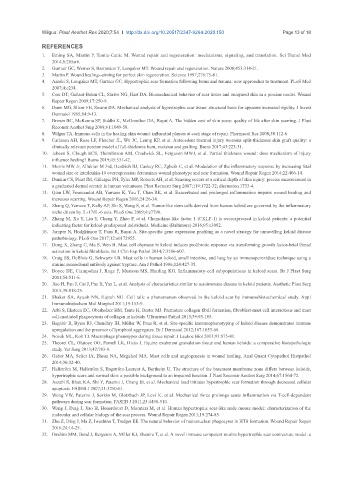Page 634 - Read Online
P. 634
Wilgus. Plast Aesthet Res 2020;7:54 I http://dx.doi.org/10.20517/2347-9264.2020.150 Page 13 of 18
REFERENCES
1. Eming SA, Martin P, Tomic-Canic M. Wound repair and regeneration: mechanisms, signaling, and translation. Sci Transl Med
2014;6:265sr6.
2. Gurtner GC, Werner S, Barrandon Y, Longaker MT. Wound repair and regeneration. Nature 2008;453:314-21.
3. Martin P. Wound healing--aiming for perfect skin regeneration. Science 1997;276:75-81.
4. Aarabi S, Longaker MT, Gurtner GC. Hypertrophic scar formation following burns and trauma: new approaches to treatment. PLoS Med
2007;4:e234.
5. Corr DT, Gallant-Behm CL, Shrive NG, Hart DA. Biomechanical behavior of scar tissue and uninjured skin in a porcine model. Wound
Repair Regen 2009;17:250-9.
6. Dunn MG, Silver FH, Swann DA. Mechanical analysis of hypertrophic scar tissue: structural basis for apparent increased rigidity. J Invest
Dermatol 1985;84:9-13.
7. Brown BC, McKenna SP, Siddhi K, McGrouther DA, Bayat A. The hidden cost of skin scars: quality of life after skin scarring. J Plast
Reconstr Aesthet Surg 2008;61:1049-58.
8. Wilgus TA. Immune cells in the healing skin wound: influential players at each stage of repair. Pharmacol Res 2008;58:112-6.
9. Carlsson AH, Rose LF, Fletcher JL, Wu JC, Leung KP, et al. Antecedent thermal injury worsens split-thickness skin graft quality: a
clinically relevant porcine model of full-thickness burn, excision and grafting. Burns 2017;43:223-31.
10. Jabeen S, Clough ECS, Thomlinson AM, Chadwick SL, Ferguson MWJ, et al. Partial thickness wound: does mechanism of injury
influence healing? Burns 2019;45:531-42.
11. Morris MW Jr, Allukian M 3rd, Herdrich BJ, Caskey RC, Zgheib C, et al. Modulation of the inflammatory response by increasing fetal
wound size or interleukin-10 overexpression determines wound phenotype and scar formation. Wound Repair Regen 2014;22:406-14.
12. Dunkin CS, Pleat JM, Gillespie PH, Tyler MP, Roberts AH, et al. Scarring occurs at a critical depth of skin injury: precise measurement in
a graduated dermal scratch in human volunteers. Plast Reconstr Surg 2007;119:1722-32; discussion 1733-4.
13. Qian LW, Fourcaudot AB, Yamane K, You T, Chan RK, et al. Exacerbated and prolonged inflammation impairs wound healing and
increases scarring. Wound Repair Regen 2016;24:26-34.
14. Zhang Q, Yamaza T, Kelly AP, Shi S, Wang S, et al. Tumor-like stem cells derived from human keloid are governed by the inflammatory
niche driven by IL-17/IL-6 axis. PLoS One 2009;4:e7798.
15. Zhang M, Xu Y, Liu Y, Cheng Y, Zhao P, et al. Chemokine-like factor 1 (CKLF-1) is overexpressed in keloid patients: a potential
indicating factor for keloid-predisposed individuals. Medicine (Baltimore) 2016;95:e3082.
16. Jumper N, Hodgkinson T, Paus R, Bayat A. Site-specific gene expression profiling as a novel strategy for unravelling keloid disease
pathobiology. PLoS One 2017;12:e0172955.
17. Dong X, Zhang C, Ma S, Wen H. Mast cell chymase in keloid induces profibrotic response via transforming growth factor-beta1/Smad
activation in keloid fibroblasts. Int J Clin Exp Pathol 2014;7:3596-607.
18. Craig SS, DeBlois G, Schwartz LB. Mast cells in human keloid, small intestine, and lung by an immunoperoxidase technique using a
murine monoclonal antibody against tryptase. Am J Pathol 1986;124:427-35.
19. Boyce DE, Ciampolini J, Ruge F, Murison MS, Harding KG. Inflammatory-cell subpopulations in keloid scars. Br J Plast Surg
2001;54:511-6.
20. Jiao H, Fan J, Cai J, Pan B, Yan L, et al. Analysis of characteristics similar to autoimmune disease in keloid patients. Aesthetic Plast Surg
2015;39:818-25.
21. Shaker SA, Ayuob NN, Hajrah NH. Cell talk: a phenomenon observed in the keloid scar by immunohistochemical study. Appl
Immunohistochem Mol Morphol 2011;19:153-9.
22. Arbi S, Eksteen EC, Oberholzer HM, Taute H, Bester MJ. Premature collagen fibril formation, fibroblast-mast cell interactions and mast
cell-mediated phagocytosis of collagen in keloids. Ultrastruct Pathol 2015;39:95-103.
23. Bagabir R, Byers RJ, Chaudhry IH, Müller W, Paus R, et al. Site-specific immunophenotyping of keloid disease demonstrates immune
upregulation and the presence of lymphoid aggregates. Br J Dermatol 2012;167:1053-66.
24. Novak ML, Koh TJ. Macrophage phenotypes during tissue repair. J Leukoc Biol 2013;93:875-81.
25. Theoret CL, Olutoye OO, Parnell LK, Hicks J. Equine exuberant granulation tissue and human keloids: a comparative histopathologic
study. Vet Surg 2013;42:783-9.
26. Gaber MA, Seliet IA, Ehsan NA, Megahed MA. Mast cells and angiogenesis in wound healing. Anal Quant Cytopathol Histpathol
2014;36:32-40.
27. Hellström M, Hellström S, Engström-Laurent A, Bertheim U. The structure of the basement membrane zone differs between keloids,
hypertrophic scars and normal skin: a possible background to an impaired function. J Plast Reconstr Aesthet Surg 2014;67:1564-72.
28. Aarabi S, Bhatt KA, Shi Y, Paterno J, Chang EI, et al. Mechanical load initiates hypertrophic scar formation through decreased cellular
apoptosis. FASEB J 2007;21:3250-61.
29. Wong VW, Paterno J, Sorkin M, Glotzbach JP, Levi K, et al. Mechanical force prolongs acute inflammation via T-cell-dependent
pathways during scar formation. FASEB J 2011;25:4498-510.
30. Wang J, Ding J, Jiao H, Honardoust D, Momtazi M, et al. Human hypertrophic scar-like nude mouse model: characterization of the
molecular and cellular biology of the scar process. Wound Repair Regen 2011;19:274-85.
31. Zhu Z, Ding J, Ma Z, Iwashina T, Tredget EE. The natural behavior of mononuclear phagocytes in HTS formation. Wound Repair Regen
2016;24:14-25.
32. Ibrahim MM, Bond J, Bergeron A, Miller KJ, Ehanire T, et al. A novel immune competent murine hypertrophic scar contracture model: a

